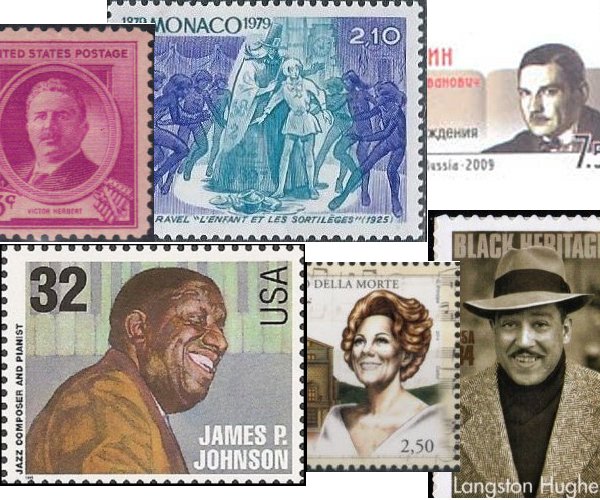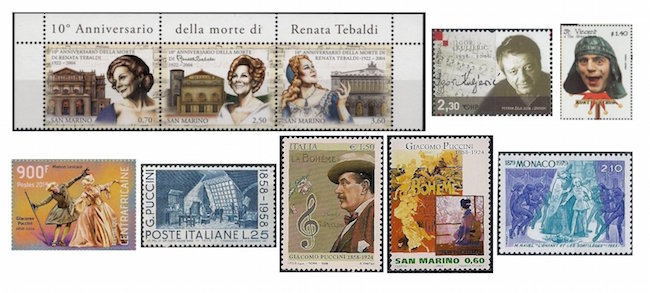The Arts on the Stamps of the World — February 1
An Arts Fuse regular feature: the arts on stamps of the world.

By Doug Briscoe
February 1 is another full day for the arts on stamps: the birthday of Victor Herbert, Hugo von Hofmannsthal, Yevgeny Zamyatin, James P. Johnson, Langston Hughes, John Ford, Clark Gable, Renata Tebaldi, and Monty Python’s Terry Jones!
Oh, and Conrad Celtes and Thomas Cole and Igor Kuljerić, and it’s the anniversary of the first performances of Puccini’s La bohème and Manon Lescaut and Ravel’s L’enfant et les sortilèges.
Conrad Celtes (1 February 1459 – 4 February 1508), a German humanist scholar and poet, was born Konrad Bickel or Pyckell in northern Bavaria. He was able to study at the Universities of Cologne and Heidelberg, where one of his teachers was Rodolphus Agricola, and after lecturing throughout Germany and Italy went on to even further study at Jagiellonian University in Kraków. Celtes founded literary societies in at least three cities and received many honors. His first publication was Ars versificandi et carminum (The Art of Writing Verses and Poems, 1486), but he is of particular importance as an historian. A word about the stamp: it was issued in 1944 during the Nazi occupation (“General Gouvernement”) of Poland.
Thomas Cole (1801 – February 11, 1848) is acknowlegded as the founder of the Hudson River School. Born in Lancashire, England, he came to the U.S. in 1818. Beginning work as an engraver, he soon moved on to portrait painting, and then to the landscapes and history paintings for which he is best known. Seen on this USPS issue from 2014 is Cole’s Distant View of Niagara Falls (1830).
Victor Herbert (1859 – May 26, 1924), born in Dublin, played flute and piccolo before settling on the cello as both orchestral player (in a number of German orchestras) and soloist. In the 1880 season he appeared with the Eduard Strauss orchestra in Vienna, and Brahms chose him for a chamber orchestra performance in honor of Liszt in 1883. While playing with the Stuttgart court orchestra he began composing and premièred his own Suite for cello and orchestra and First Cello Concerto. He married soprano Therese Förster (1861–1927) in 1886, and in that year the couple moved to New York, both of them having been hired by Walter Damrosch and Anton Seidl for the Metropolitan Opera (Herbert as principal cello in the orchestra). The first (Prince Ananias) in the series of operettas for which Herbert is so famous was written in 1887. When that form fell out of favor during World War One, he turned, with some reluctance, to musical comedy, but he also wrote two grand operas, Natoma (1911), in which the young John McCormack made his opera debut alongside Mary Garden, and Madeleine of 1914. In 1916 Herbert wrote one of the earliest scores for a full-length film, The Fall of a Nation. What may not be so well known about Herbert is that he was one of the founders of ASCAP, its vice-president and director from 1914 to his death in 1924. The US stamp comes from a set of composer stamps issued in 1940; the one from Lesotho from a set celebrating our bicentennial.
Author of novels, plays, poetry, and essays, Hugo von Hofmannsthal (1874 – July 15, 1929) is best known to us as the author of six libretti for operas by Richard Strauss: Elektra, Der Rosenkavalier (with Harry von Kessler; Hofmannsthal later wrote a screenplay for a 1925 film of this opera), Ariadne auf Naxos, Die Frau ohne Schatten, Die ägyptische Helena, and Arabella. Hofmannsthal also adapted the famous 15th century English morality play Everyman (as Jedermann), for which Sibelius wrote incidental music in 1916. Frank Martin wrote his Six Monologues from Jedermann for baritone and piano in 1943-44 (orchestrated 1949 and recorded in that version by Dietrich Fischer-Dieskau).
I was introduced to Yevgeny Zamyatin’s famous satirical novel We (1921) in a fondly-remembered college course on Russian literature. Zamyatin ([OS 20 January] 1884 – 10 March 1937), arrested and exiled to Siberia for his involvement in the 1905 revolution, developed into an enthusiastic Bolshevik until he became disgusted with their repressive policies. We was the first work to be banned by the Soviet censorship board. After Zamyatin arranged for the novel to be smuggled to the West in 1927, he was granted his request for exile, thus earning a place in history as one of the first Soviet dissidents. He died of a heart attack in Paris. There is no stamp for him, but Russia issued a postal card in 2008. The book title seen at front is of Uezdnoe (oo-YEZD-na-yeh; A Provincial Tale), a collection of 15 short stories published in 1913.

James P. Johnson (1894 – November 17, 1955) is perhaps the most important name in ragtime after Scott Joplin, though he went on to work in various genres. Born in New Jersey, he was blessed with perfect pitch and studied the classical tradition before establishing himself as a prominent ragtime pianist and making dozens of piano rolls. Johnson was a pioneer of stride and bridged the transition from rag to jazz, making some of the first jazz piano solos on record. Later, partly because his style began to fall out of favor, he turned to composing orchestral music in the classical mold as well as continuing his work in jazz, musical theater, and film scores. He collaborated with Langston Hughes (see next paragraph!) on a one-act opera called De Organizer. The stamp derives from a sheet of ten jazz musicians issued in 1995.
Mary Patterson, the grandmother of American poet Langston Hughes (1902 – May 22, 1967), was one of the first women to attend Oberlin College and married a man who took part in John Brown’s Harpers Ferry raid and died of his wounds. Her second husband was the father of Caroline Langston, who in turn was the mother of the poet. Langston Hughes was born (eight years to the day after James P. Johnson) in Joplin, Missouri, and grew up in several different small towns in the Midwest, mainly residing with Mary Patterson in Lawrence, Kansas. After her death, Hughes went to high school in Cleveland, where some of his writing was for the school newspaper, and continued his unusually peripatetic existence, visiting his father in Mexico, studying at Columbia University, serving on a ship that took him across the Atlantic, falling in love in Paris, living in England for a while, then in Washington, D.C., where he worked with historian Carter G. Woodson, and finally settling in Harlem. He was one of the primary figures in the Harlem Renaissance and was one of the exponents of jazz poetry. His work as a writer and activist was of far-reaching importance for the African-American experience. Besides poems, Hughes wrote novels, stories, plays, co-wrote the screenplay for Way Down South (1939) with Clarence Muse, and, as stated above, wrote an opera libretto for James P. Johnson.
Two of the icons of American cinema share this February 1 birthday: John Ford and Clark Gable. Ford (1894 – August 31, 1973) won Best Director Oscars six times: for The Informer (1935), The Grapes of Wrath (1940), How Green Was My Valley (1941), The Quiet Man (1952), and two for World War II documentaries, but never for the Westerns with which his name was so closely associated. He was, however, nominated for 1939’s Stagecoach, seen on one of a group of four 1990 stamps recalling favorite American films. The very same set also celebrated Gone with the Wind (1939), for which Clark Gable (1901 – November 16, 1960) received one of his two Best Actor nominations, the other being for Mutiny on the Bounty (1935). His only win was earned for It Happened One Night (1934).

The great Italian soprano Renata Tebaldi (1922 – 19 December 2004) was born in Pesaro, the daughter of a cellist. She studied in Parma and made her debut in Boito’s Mefistofele in Rovigo in 1944. When La Scala reopened after the war, she sang in a concert under Toscanini, who said she had “the voice of an angel.” She made her La Scala, Covent Garden, and US debuts in 1950, as Aida (at La Scala and the San Francisco Opera) and Desdemona. (Tebaldi dubbed the singing voice for Sophia Loren in the 1953 film of Aida.) Her Metropolitan Opera debut, again as Desdemona, took place in 1955, the day before her 33rd birthday. She remained with the Met for 17 years, besides appearing at other houses. She retired in the 70s and died, having never married, in her home in San Marino. Just three years ago, that tiny nation issued this striking sheet of three stamps to commemorate the tenth anniversary of her passing.
Croatian musician Igor Kuljerić (1938 – April 20, 2006), besides his significance as a composer and conductor, was harpsichordist with I Solisti di Zagreb and assistant to that ensemble’s conductor Antonio Janigro. Kuljerić’s career began with studies under Stjepan Šulek and at La Scala. Kuljerić directed a number of musical organizations and festivals. In his wide-ranging compositions he often investigated such variegated avenues as folksong, Orthodox religious music, tape, and multimedia, but his avant-garde works coexist with crossover projects in pop and rock, TV jingles, etc. He also wrote a large amount of film music. The stamp was issued two years after his death, days before what would have been his 70th birthday.
The brilliant Terry Jones was born Terence Graham Parry Jones in Wales on this day in 1942, but grew up in Surrey. He studied English and history at Oxford, performing in comedy routines there with Michael Palin. He wrote for David Frost and did other work in television just prior to the première of Monty Python’s Flying Circus in 1969. Besides directing a number of films, including Life of Brian and The Meaning of Life, Jones has written books of history and poetry. Tragically, he was diagnosed with primary progressive aphasia last year and is no longer able to give interviews. The stamp comes from a Monty Python sheet issued by Saint Vincent and the Grenadines for the show’s thirtieth anniversary.
Three operas that also are referenced on postage stamps were premièred on this date, two of them by Puccini! First heard on February 1st were Manon Lescaut of 1893 and La bohème of 1896, both premièred in Turin, and Ravel’s L’enfant et les sortilèges, first given in 1926 in Monte Carlo. I mentioned L’enfant just a few days ago on the birthday of Colette (1/28), who wrote the libretto.
A graduate of the University of Massachusetts with a B.A. in English, Doug Briscoe worked in Boston classical music radio, at WCRB, WGBH, and WBUR, for about 25 years, beginning in 1977. He has the curious distinction of having succeeded Robert J. Lurtsema twice, first as host of WGBH’s weekday morning classical music program in 1993, then as host of the weekend program when Robert J.’s health failed in 2000. Doug also wrote liner notes for several of the late Gunther Schuller’s GM Recordings releases as well as program notes for the Boston Classical Orchestra. For the past few years he’s been posting a Facebook “blog” of classical music on stamps of the world, which has now been expanded to encompass all the arts for The Arts Fuse.
